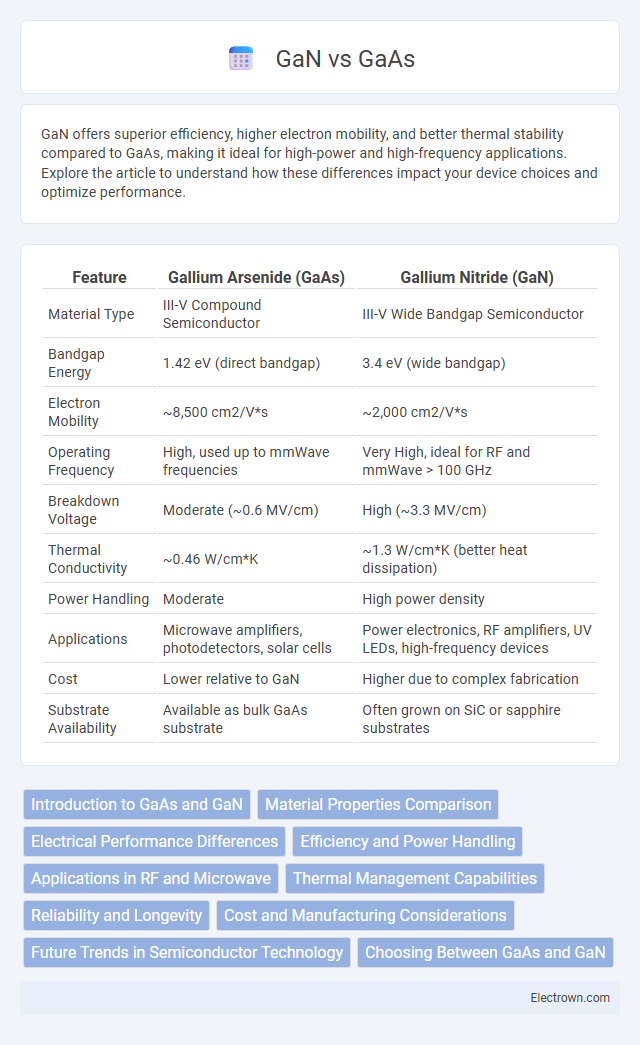GaN offers superior efficiency, higher electron mobility, and better thermal stability compared to GaAs, making it ideal for high-power and high-frequency applications. Explore the article to understand how these differences impact your device choices and optimize performance.
Table of Comparison
| Feature | Gallium Arsenide (GaAs) | Gallium Nitride (GaN) |
|---|---|---|
| Material Type | III-V Compound Semiconductor | III-V Wide Bandgap Semiconductor |
| Bandgap Energy | 1.42 eV (direct bandgap) | 3.4 eV (wide bandgap) |
| Electron Mobility | ~8,500 cm2/V*s | ~2,000 cm2/V*s |
| Operating Frequency | High, used up to mmWave frequencies | Very High, ideal for RF and mmWave > 100 GHz |
| Breakdown Voltage | Moderate (~0.6 MV/cm) | High (~3.3 MV/cm) |
| Thermal Conductivity | ~0.46 W/cm*K | ~1.3 W/cm*K (better heat dissipation) |
| Power Handling | Moderate | High power density |
| Applications | Microwave amplifiers, photodetectors, solar cells | Power electronics, RF amplifiers, UV LEDs, high-frequency devices |
| Cost | Lower relative to GaN | Higher due to complex fabrication |
| Substrate Availability | Available as bulk GaAs substrate | Often grown on SiC or sapphire substrates |
Introduction to GaAs and GaN
Gallium Arsenide (GaAs) and Gallium Nitride (GaN) are III-V compound semiconductors widely used in high-frequency and high-power electronic devices. GaAs offers superior electron mobility, making it ideal for high-speed integrated circuits and optoelectronics such as LEDs and laser diodes. GaN exhibits a wide bandgap, high breakdown voltage, and excellent thermal stability, which enables efficient power amplification and operation in harsh environments.
Material Properties Comparison
GaAs (Gallium Arsenide) offers high electron mobility and direct bandgap of 1.43 eV, making it ideal for high-frequency applications and optoelectronics, while GaN (Gallium Nitride) has a wider bandgap of 3.4 eV, higher breakdown voltage, and superior thermal conductivity, which enables high-power and high-temperature device operation. GaN's higher electron saturation velocity and robustness against radiation make it preferable for power electronics and RF amplifiers in harsh environments, contrasting with GaAs's efficiency in low-noise, high-speed digital circuits. The intrinsic material properties of GaN support higher voltage, current density, and frequency performances, positioning it as a strong candidate for next-generation power semiconductors.
Electrical Performance Differences
Gallium Nitride (GaN) exhibits superior electrical performance compared to Gallium Arsenide (GaAs) due to its higher electron mobility and wider bandgap, which enable faster switching speeds and higher breakdown voltages. GaN's ability to operate at higher temperatures and frequencies makes it ideal for high-power, high-frequency applications such as RF amplifiers and power electronics. In contrast, GaAs offers excellent electron mobility suitable for microwave and millimeter-wave applications but is limited by lower thermal conductivity and breakdown voltage relative to GaN.
Efficiency and Power Handling
Gallium Nitride (GaN) transistors exhibit significantly higher efficiency and power handling capabilities compared to Gallium Arsenide (GaAs) devices, making GaN preferred for high-frequency and high-power applications such as RF amplifiers and power converters. GaN's wider bandgap of 3.4 eV enables operation at higher voltages, temperatures, and frequencies, resulting in reduced energy losses and improved thermal performance over GaAs, which has a bandgap of 1.42 eV. The superior electron mobility and saturation velocity in GaN translate to faster switching speeds and greater power density, further enhancing overall system efficiency and reliability.
Applications in RF and Microwave
GaN technology outperforms GaAs in RF and microwave applications due to its higher power density and thermal conductivity, making it ideal for high-power amplifiers in radar and 5G base stations. GaAs remains preferred for low-noise amplifiers and high-frequency circuits where signal fidelity and sensitivity are crucial. Your choice between GaN and GaAs depends on the specific power and frequency requirements of your RF or microwave system.
Thermal Management Capabilities
Gallium Nitride (GaN) exhibits superior thermal management capabilities compared to Gallium Arsenide (GaAs) due to its higher thermal conductivity, which enables better heat dissipation in high-power electronic devices. GaN's ability to operate efficiently at elevated temperatures reduces the need for extensive cooling systems, enhancing device reliability and performance in demanding applications. When optimizing your power electronics, choosing GaN can significantly improve thermal management and overall system efficiency.
Reliability and Longevity
GaN devices exhibit higher reliability and longer operational lifespans compared to GaAs due to superior thermal conductivity and robustness under high power and voltage conditions. GaAs components tend to degrade faster when exposed to elevated temperatures and stress, limiting their longevity in demanding applications. Your choice of GaN technology ensures enhanced durability, reducing maintenance costs and downtime in critical systems.
Cost and Manufacturing Considerations
GaAs (Gallium Arsenide) generally incurs higher material costs due to its complex crystal growth process compared to GaN (Gallium Nitride), which benefits from abundant raw materials and scalable manufacturing techniques. GaN fabrication leverages mature silicon substrate technology, reducing overall production expenses and enabling higher volume manufacturing. Cost efficiency in GaN devices often surpasses GaAs, especially for high-power and high-frequency applications where wafer size and yield improvements are critical.
Future Trends in Semiconductor Technology
GaN semiconductors are rapidly gaining traction over GaAs due to their superior electron mobility, higher breakdown voltage, and enhanced thermal stability, making them ideal for next-generation power electronics and high-frequency applications. Emerging trends indicate that GaN will dominate 5G infrastructure, electric vehicles, and renewable energy systems because of its efficiency and scalability advantages. You can expect continued innovation in GaN-based devices to drive faster, more energy-efficient semiconductor technologies in the future.
Choosing Between GaAs and GaN
GaAs (Gallium Arsenide) offers excellent electron mobility, making it ideal for high-frequency applications such as RF and microwave devices, while GaN (Gallium Nitride) excels in high-power and high-temperature environments due to its superior thermal conductivity and breakdown voltage. Your choice between GaAs and GaN depends on specific device requirements, with GaAs preferred for low-noise amplifiers and GaN favored for power amplifiers and switching devices. Evaluating the operational frequency, power handling, and thermal conditions of your application will guide the optimal semiconductor selection.
GaAs vs GaN Infographic

 electrown.com
electrown.com